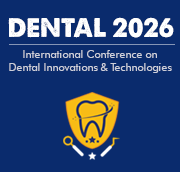Title : Riboflavin mediated photo-illumination for bonding zirconia to tooth structure
Abstract:
Photodynamic therapy (PDT) is a photochemical reaction that causes selective minimally invasive and non- toxic destruction of a tissue using a photosensitiser and a light source and it can be used in treating localised microbial infections. Riboflavin (RF) is cross-linking photosensitiser-like agent that acts as an inhibitor of collagen degradation after the destructive activity of the acid-based bacteria, such as Streptococcus mutans (S. mutans). Mesoporous silica nanoparticles (MSN), which are a class of porous materials having a considerable number of pores and excellent surface area that load several amounts of drugs within for enhanced effectiveness.
Objective of the current study is to formulate and characterize RF-loaded MSN (RF@MSN) in adhesive for bonding zirconia ceramic to tooth structure for potential application in crowns and bridge restorations. RF was loaded inside MSN to produce RF@MSN and doped with adhesive resin. The morphological characterisation of the RF@MSN using scanning and transmission electron microscopy (SEM &TEM) showed round nanoparticles of size averaging 200–500 nm. Morphological and spectral characterization of the nanoparticles were studied. RF@MSN in adhesive with two varying concentrations (0.25wt.% and 0.5 wt.%) were studied for the degree of conversion (DC), antimicrobial activity, cytotoxicity, and shear bond strength (SBS) after luting zirconia to tooth dentin samples. After activation with a diode laser, 0.5 wt.% RF@MSN samples showed the least DC scores (39.56 ± 5.54), while the highest SBS scores (1018 ± 78 MPa) were reported by control group. 0.5 wt.% RF@MSN samples showed the highest anti- microbial capacity for adhesive against S. mutans. Incorporation of RF@MSN in dentin adhesive showed improved mechanical and antibacterial efficacy after photo illumination following bonding zirconia to the tooth structure.



